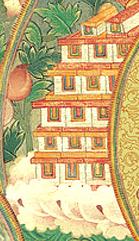Dharma: Difference between revisions
Jump to navigation
Jump to search
No edit summary |
|||
| Line 7: | Line 7: | ||
==Eight Qualities of the Dharma== | ==Eight Qualities of the Dharma== | ||
{{:Eight qualities of the Dharma}} | |||
==Further Reading== | ==Further Reading== | ||
Revision as of 20:43, 11 June 2009

Dharma (Skt. dharma; Tib. chö; Wyl. chos) — the word used to refer to the teachings of the Buddha (Skt. Buddhadharma). It has many shades of meaning, including ‘the spiritual path’, or ‘spirituality’ in general. It also refers to phenomena, meaning things and events. See also ten meanings of Dharma.
Subdivisions
Eight Qualities of the Dharma
According to Maitreya's Uttaratantra Shastra, the Dharma has eight qualities of cessation and the path:
Path:
- 1) purity, since free from emotional obscurations
- 2) clarity, since free from cognitive obscurations
- 3) remedy, since it overcomes both obscurations
Cessation:
- 4) inconceivable, since beyond concepts
- 5) utterly peaceful, since it is free from karma and disturbing emotions
- 6) unfathomable, since individually cognized
And
- 7) cessation; and
- 8) the path.
Further Reading
- Khenpo Ngawang Palzang, A Guide to the Words of My Perfect Teacher, Shambhala, 2004, pages 107-108.